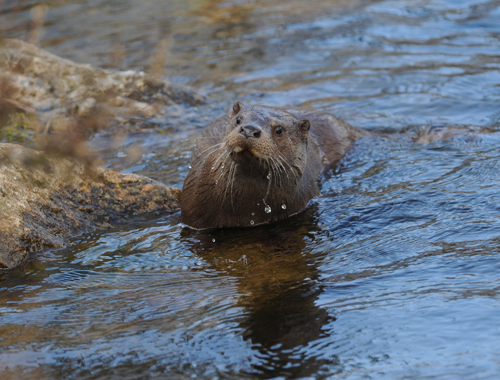Otter
- a secret life in the watercourses
You can safely say that the otter lives a secret life in the watercourses. It is active only at night and it is very difficult to spot. It is only revealed by its footprints and droppings.
Otter footprints are easy to recognize because it has webbed toes. You will typically find otter footprints on the sand and mud banks along rivers and by road bridges.
Otter droppings have a very special smell and often contain many fish scales.
The otter lives mainly on fish like perch, eel, carp and eelpout. It can also eat frogs and small mammals, birds and crustaceans.
The otter lives in undisturbed watercourses, lakes, bogs and inlet areas, where it has the possibility to hide in the vegetation.
Road deaths
Road deaths are a frequent cause of death of the otherwise very shy animals. The otter does not like to swim under bridges and it therefore often seeks to come out of the water to cross the road. A portion of the road deaths could be avoided by making passages of stone, grass or sand banks under the bridges.
In the 1950s, the otter was fairly widespread in Denmark. Until the 1980s the population declined, although the otter became a protected species in 1967.
Many of the otter's natural living areas disappeared when the rivers were straightened out, and the population was also affected by environmental toxins, which were released into the nature at that time.
The otter making progress
In the 1980s, there were only about 200 remaining otters in Denmark, mainly in North Jutland. Therefore a number of measures were implemented to ensure a more undisturbed habitat for the shy animals.
Since the 1980s, the population has been growing steadily. At the most recent count, traces of otters were found in almost every major river in Jutland. The population is now estimated to be between 600 and 800 animals.
Traces of otters have been found at several places along the river Kongeå.
Facts about the otter
Length: 100-130 cm
Weight male: 6-11 kg
Weight female: 5-8 kg
Flat head with small ears. Nostrils and eyes are positioned high on the head, so that it can see, hear and breathe while it is swimming.
Long and streamlined body. Brown fur with light underside. Webbed toes.
The otter population in Denmark is estimated to be between 600 and 800 animals. The otter lives in almost all watercourses in Jutland.


